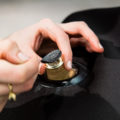– Sabina Kassoumova, The quest for elsewhere –
On Friday 16 June 2017, the premises of the Digital Agency THE FARM were taken over by the ephemeral exhibition “Fernweh” by the Russian artist Sabina Kassoumova. This event was organized in collaboration with LEALM, “Les EXPOS à la MAISON”, which aims to create “original moments” and “proximity” through a new experience of art. The concept is atypical! Your home or any other living space becomes the time of an evening, an exhibition space in the image of an art gallery. The mind is about discovery and artistic encounters, but above all human.
Sabina Kassoumova’s work was totally integrated with the exhibition space. Deployed on all three levels, the scenography participated step by step in the discovery of his works, in a random, upward and downward movement. The close relationship between the two preferred media – photography and video – is significant to the artist’s practice. Both archival techniques oscillate between artistic and documentary value. However, this complementary interaction does not affect the independence of each work. Colour and medium format photographs, for example, can be considered outside their serial connection. This is the strength of his work. His videos are oral confessions and his photographs are silent stories. Each in turn, they shut us up and make us talk. Sabina Kassoumova plays with this ambivalence of what is and what is not, or rather, what is no longer. It’s a quest. The other’s and the other’s. Sabina Kassoumova saw the distance. This step back from a front is the source of his research. She has been living in Paris since 2002, after a brief stint at the Beaux-Arts de Bordeaux, and graduated in 2014 from the Ecole Nationale Supérieure d’Arts de Paris-Cergy. Having left his native land and roots, the artist is still on the road to exile.

Measurement is therefore essential in its production. Sabina Kassoumova positions us according to her own experience of her fellow human being, moving us away from and closer to the men and women from whom her work is formed. His technique is a journey, full of encounters. The individual has a central place in it. Their concrete presence in the videos counterbalances their near absence in his photographs. Because even if the human appears in the latter, the cliché taken fixes the moment of their mistakes, both physical and mental. Our gaze trying to connect with someone, thus gets lost in the photographed space. His photos make the individual lose his identity, which becomes an anonymous and almost fleeting shadow. Sabina Kassoumova tries to capture what she thinks is this “temporary state”. This “moment of floating” is very visible in the Moscow / Toula series dating from 2012. This pivotal year in his work marked the artist’s return to his childhood city Moscow where his family settled after spending a few months in Tula, the other place of his ties. His photographs are rarely taken indoors, but rather in the space of the city, without limits, which absorbs the figure, often curved under the weight of its condition. This state of circumstances induces a notion of temporality and the places and people she photographs are subject to it. His 2015 series, carried out in Barentsburg, Norway, on the west coast of the island of Spitsbergen, is an example. Life seems to be frozen in a bygone era, when the path of modernization has not been forged. In pairs, the photographic views alternate the omnipresence of a void and the eclipse of the living.

The unknown, Sabina Kassoumova, is looking for it, because in the end it is what brings her closer to these individualities; they are expatriates. Equipped with her camera, she sets off on a hazardous adventure of possible encounters with them. However, family memory plays a central role in his documentaries, both his own and those of others. The artist refocuses here on the personal distance that each person imposes or suffers. In the video Casemates, 2015, we follow the path of Vitalik his cousin, Valya his grandmother’s best friend and Natacha his uncle’s first wife. From this sociological approach, two working funds coexist: Two hands on the map separate us and stories on the map: East Sussex. The familiar and the distant. The artist extracts himself from the image as much as possible to give free rein to endless dialogues, with an open heart in a moment of exchange of great humanity. In 2016, she invited people in the East Sussex region of England, all of whom were similar in their exile condition, to discuss it. Sixteen people from different countries came to confide in us about their adventures, all of them singular. Immersion in the stories is complete, in turn, a known but often overlooked world emerges around these stories.

The new Fernweh series, presented for the first time, closed the exhibition. On the window framing a landscape image, the artist paints a curtain, a veil blurring our vision. The title in German consists of “fern”: far and “weh”: evil. It is translated by “desire for a change of scenery” or “fidgeting” that she literally appropriates, unlike homesickness, “homesickness” in English, her antonym. His lack of German language allows him a greater freedom of creation and association of ideas. This endless exploration of territory, begun a few years ago by Sabina Kassoumova, is unique because of its need to “go and see elsewhere”. For her, “There is not only one truth, there are a multitude of experiences and to hear them is to open your eyes to a different world”.

Diane Der Markarian
Featured image : Sabina Kassoumova, série “Moscou / Toula”, 2012, tirages sur papier argentique satiné. © Sabina Kassoumova / ADAGP.






